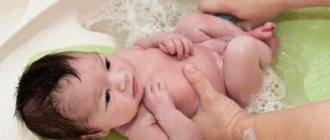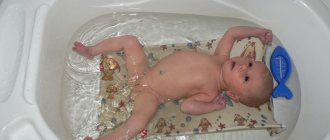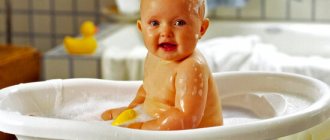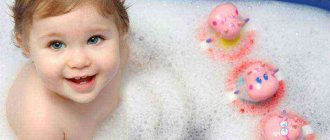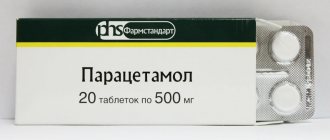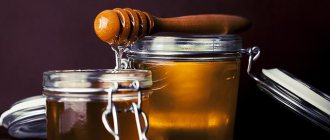Our great-grandmothers also added decoctions of medicinal herbs to the water for bathing babies. Thus, they disinfected the water and solved many other issues. But there are a huge number of medicinal herbs, which of them can be used for bathing newborns and in what situations? This is exactly what our article is about.
Bathing a baby - is it just a hygienic procedure?
In addition to the fact that bathing is intended to keep the baby's body clean, this procedure has a beneficial effect on a number of important functions of the small body.
What functions are we talking about?
Bathing helps relax and calm your baby. By adjusting the water temperature, you can normalize the child’s muscle tone. After all, the aquatic environment for a newborn is natural and familiar. This is especially important if the baby has a noticeable state of hypertonicity.
In water, it is easier for a child to make all movements. Including breathing movements. Even during passive swimming (just lying in the water), the chest opens better. The baby's body receives more oxygen.
Moreover, often the baby begins to actively flounder in the water. Then the muscles of the whole body are involved. This provides an even greater improvement in blood flow, being a powerful impetus for the harmonious physical development of the baby and improved health in general.
This kind of physical activity is very important for a newborn, as it has a beneficial effect on the baby’s appetite and sleep. It’s no wonder that after bathing, children eat with great appetite and fall asleep soundly.
Bathing also helps develop and train the vestibular system of a newborn.
Daily bathing with regulation of the water temperature will serve as a hardening procedure for the baby. After all, it is much more effective than air baths.
Also, the increased air humidity that is created in the room during and after bathing creates conditions for clearing the baby’s respiratory tract. Therefore, it is easier for a child to breathe in such a room.
Moisturized mucous membranes of the upper respiratory tract thus do not lose their protective functions - they are promptly cleaned of dust and microorganisms settling on them
Bathing a newborn in water with the addition of herbal decoctions makes it possible to solve the problem of skin rashes and calm an excited baby.
Daily water procedures also provide the opportunity for close physical contact between the baby and the mother, which is very necessary for him at this age.
Dad's participation in such an important procedure gives him a feeling of irreplaceability, importance and a lot of positive emotions. Moreover, all participants in the procedure receive positive emotions, even euphoria.
All of the above is the answer to most parents who ask about the required frequency of bathing - you need to bathe every day. No weekends or holidays.
It’s clear that a small child doesn’t get that dirty. But we bathe the baby not only to wash it.
Helpful: Why might a red spot form on the back of a child’s head?
Weak, painful, and premature babies can be bathed even twice a day. This will only benefit them.
Mint tea for children
Mint normalizes the emotional background of the child, helps the fragile nervous system cope with stress and shock. But exactly how it affects the small organism still remains a mystery.
Very often, the use of plants leads to allergies, and both a two-month-old infant and an almost adult teenager can develop a rash. Mint tea should be given only after consultation with a specialist in order to avoid side effects from such tea drinking.
Herbal tea is a rather controversial drink that can both improve health, promote a speedy recovery, and cause serious damage to the body. Each type of tea should be given according to age characteristics. It is still not recommended to give mint tea to your baby; allergies will not take long to develop.
Data. Doctors say that regular use of mint reduces the likelihood of the formation of malignant tumors. Scientific research is still underway, but most likely the plant prevents the development of oncology of the respiratory, digestive and skin organs.
However, if you are confident in your baby, then it is better to give preference to industrially produced baby mint teas. For example, the company Babushkino Lukoshko produces mint tea for children from three months. This drink contains a clearly calculated dosage of herbs for the child’s body.
At what age can you bathe a newborn in herbs?
Upon arrival from the maternity hospital, it is recommended to bathe the child for some time in water with a weak solution of potassium permanganate.
It is believed that after the umbilical wound has healed (day 10-14), herbs can be added to the bath for bathing newborns.
But there are cases when a child develops prickly heat, diaper rash, cracks in the folds of the skin, behind the ears, or an allergic rash in response to a new product eaten by the mother. If you have such problems, you can bathe your baby in herbs immediately after birth in order to resolve them.
What do parents need to know before bathing their baby in herbs?
The child's body is very receptive to any new products and substances. Therefore, a child can be allergic to any product, even the most natural one.
This also applies to herbs. After all, herbs are a storehouse of a wide variety of biologically active substances. Even the safest herb (according to most parents), chamomile, can cause an allergic reaction in a baby.
In this regard, before adding a decoction of any herb to a child’s bath, you need to conduct a kind of test.
Soak a piece of cotton wool in the prepared herbal solution and wipe it on a small area of the child's skin on the forearm near the wrist.
If after half an hour there are no skin reactions in this area, then you can add the solution to the bath. If there is any reaction, then this herb should not be used.
Multicomponent decoctions should not be used immediately in newborns. In the case of allergic reactions, it will be impossible to determine which herb is to blame.
The collection can be used only when there is confidence that the baby is not allergic to all its components. For example, when a child was bathed in these herbs separately, no allergic reactions were observed. It is better to bathe your baby, adding one herb on different days of the week, than to make a “mix” of herbs.
The decoction must be infused in an enamel, glass or ceramic container, since metals can react chemically with the decoction. Aluminum is especially dangerous in this regard.
The finished herbal solution must be filtered through cheesecloth so that leaves and other particles of herb do not fall into the bath.
For bathing newborns, use only fresh decoction or infusion (store for no more than 5 hours).
It is not advisable to add herbs to the bath every day. It is better to arrange baths with herbs every other day or three times a week.
Parents themselves regulate bathing time. This depends on the temperature of the water and air in the room. And also on how quickly the water cools and how the child behaves while swimming. It is advisable not to delay bathing time for more than 15 minutes. This time is quite enough.
When bathing in herbs, you do not need to use detergents and cosmetics, since bathing in herbs does not involve rinsing with plain water at the end of bathing.
After bathing the child, it is better to immediately wrap it and dry it (using blotting movements) with a warm diaper, which you don’t mind if it doesn’t wash off. After all, the pigment substances of herbs leave dark, difficult-to-wash stains on a towel or diaper.
Rules for preparing herbal baths for infants
For bathing you will need 2 tablespoons of dry color or herbal mixture and a glass of boiling water to prepare a concentrated infusion. The mixture is poured with boiling water, the broth should brew for at least half an hour in a clean container.
The solution must be filtered through cheesecloth and diluted in 10 liters of warm water. Any bath is taken 2-3 times a week, a course of 10 procedures, otherwise there will be no effect.
What herbs can be added to a bath for a healthy baby?
No matter how carefully parents monitor their baby, children often develop heat rash in hot weather. Large babies often suffer from diaper rash, which appears in numerous folds. Newborns spit up frequently, and breast milk can get into the creases of the neck, causing irritation there.
Most often, it is recommended to use chamomile or string for bathing newborns. These herbs can be used for both prevention and treatment of various skin problems.
There are many other beneficial medicinal herbs. But not all of them can and should be added to a newborn baby’s bath.
Let's look at the most commonly recommended bathing herbs by pediatricians and their benefits.
Useful: How to help a child if he is choking?
Chamomile flowers
Chamomile has anti-inflammatory and bactericidal properties. Well relieves any skin irritation. After all, the skin of a newborn is delicate, sensitive and prone to diaper rash and rashes.
Chamomile can also have a mild calming effect on the baby’s nervous system and helps cope with baby’s sleep disturbances.
Chamomile can be added to the water when bathing a baby who has allergic rashes.
It is important to remember that chamomile itself can sometimes cause an allergic reaction in a small child. Therefore, before the first use, do a test on the baby’s forearm, as described above.
Series
It is also recommended to add the mixture when bathing healthy babies, as it effectively eliminates any irritation, redness and rashes on the baby’s skin.
It also helps to cope with the appearance of yellow seborrheic crusts on the scalp of a newborn, which appear in almost all babies.
It is better not to use a decoction of string for daily bathing, as this herb can dry out the baby’s delicate skin.
How to brew herbs?
About 10 g of chopped herbs (about 3 tablespoons) are poured into a glass container with 600-700 ml of hot boiled water, covered with a lid, and heated in a water bath for 15 minutes. The broth needs to be stirred periodically. Then the broth is cooled, filtered, and the remaining raw materials are squeezed out. This volume will be enough for a small baby bath.
For a large bath, you need to use a more concentrated decoction, but no more than 30 g of dry herb for bathing a child.
You can calculate the proportion - use 1 g of raw material per 1 liter of bathing water. About 10 g of chamomile flowers or string for a 10-liter baby bath or 30 g for a large 30-liter bath.
Chamomile and string are often packaged in filter bags of 1.5 grams. 10 g is approximately 6 filter bags.
The benefits and harms of mint for young children
Pediatricians are still arguing about the use of mint in the treatment of ailments in young children. Is it possible to give mint to a baby? No, a newborn should definitely not be given this plant.
If we are talking about an older child, then not everything is ambiguous here either: some experts say that you can start at the age of three, while others recommend using medicines from a natural first aid kit after reaching the age of five.
Whether or not to give a decoction of mint should be decided not by the parents, but by the pediatrician, who is competent in these matters. In any case, it is worth taking into account the characteristics of the baby’s body and his tendency to allergic reactions. The decision about whether mint can be used for certain purposes must be made consciously. The possible result could be disastrous.
Data. Peppermint essential oil is widely used in dentistry. It is included in toothpastes, powders and mouth rinses. The plant freshens breath, destroys harmful bacteria and relieves inflammation in the oral cavity.
Medicinal herbs for bathing: what can a doctor prescribe?
Skin diseases
In addition to chamomile and string, if you have skin problems, you can add a nettle decoction to the bath.
Most often, nettle is used for severe and systematic skin rashes, cracks, and weeping sores. It has a powerful anti-inflammatory and wound healing effect. Nettle also softens and tones the skin.
It is impossible not to mention the positive effect of nettle decoction on hair growth and strength. Therefore, even adults often use this folk method to strengthen their hair.
Baths with oak bark are also prescribed for babies with skin irritations (prickly heat, allergic rashes, redness, diaper rash and weeping, cracks in the folds).
Oak bark contains tannins that soothe irritated skin. Thanks to its antimicrobial properties, oak bark suppresses various inflammatory reactions. It dries and, forming a kind of protective barrier, prevents the recurrence of irritation.
Since ancient times, a decoction of bay leaves has been used to treat allergic reactions. By strengthening the walls of blood vessels, it relieves inflammation and irritation.
A decoction of bay leaves is excellent for coping with itchy skin in children. In children's practice, it is more often used in the form of lotions and rubdowns.
St. John's wort is used for atopic dermatitis and pustular infections. It has disinfecting and wound-healing properties.
When treating any skin problems in adult practice, celandine is often used. It copes well with inflammation and irritation on the skin. But there is no need to use celandine in children's practice, since celandine juice in high concentrations is poisonous.
Useful: Dermatitis in an infant: diagnosis and treatment methods
Herbs for Calm
Calming herbs are used for bathing babies who have some kind of overstimulation of the nervous system, restless sleep, or the child has “confused” the circadian cycles - he sleeps during the day and is awake at night.
Valerian is one of the most common sedative herbs. It relieves the excitability of the nervous system, has an antispasmodic effect, which has a beneficial effect on the functioning of the digestive and cardiovascular systems. Valerian also has a wound-healing effect.
Lavender has a calming effect and helps to improve the baby’s sleep if he sleeps restlessly and intermittently, and often shudders in his sleep. It is also able to eliminate spasms of smooth muscles, so it is used for flatulence and colic in newborns.
Peppermint, in addition to its calming properties, also has anti-inflammatory, antiseptic and analgesic effects. Mint also has a stimulating effect on the baby’s appetite.
Oregano, lemon balm, and motherwort are used for various disorders of the nervous system. Oregano also has an analgesic effect and has a beneficial effect on the baby’s digestion and sleep.
Oregano and mint are not recommended for children with a potential risk of allergies, as they often cause allergies.
Herbs for bathing for intestinal colic
Intestinal colic is a common problem in newborn babies. Therefore, parents with such complaints often turn to the pediatrician. Your doctor may recommend adding the following herbs to your bath:
Bearberry - relieves spasm of the smooth muscles of internal organs and is able to normalize the tone of the intestinal wall, which leads to a decrease in flatulence. Also, the antimicrobial and anti-inflammatory effects of this plant allow it to be used for skin problems.
Hop cones have an antispasmodic and relaxing effect, normalize the functioning of the gastrointestinal tract.
Motherwort, in addition to its calming effect, has a powerful antispasmodic effect, thereby regulating intestinal motility (the natural movement of contents through the intestines).
Herbs to normalize muscle tone in a newborn
Any disorders of muscle tone can be diagnosed only by a doctor, therefore, treatment of these disorders with the help of herbs should only be recommended by the child’s attending physician.
For the treatment of hypertension, herbal teas are usually recommended. For example, sedative collection No. 2. It includes motherwort, peppermint leaves, valerian root, licorice root and hop cones.
But any fees must be applied with caution. And you shouldn’t start right away with multi-component fees.
They usually start with one component. When there are no negative reactions to it, then you can add another type of grass.
In such cases, you can start with a decoction of valerian, supplementing it with time with hop cones in a 1:1 ratio.
If muscle tone is reduced, a neurologist may recommend baths with pine extract or a decoction of walnut leaves.
Contraindications
People with low blood pressure, allergies to menthol and varicose veins, as well as those who have chronic kidney and liver diseases should avoid consuming mint.
Mint should be avoided during pregnancy. The plant has many side effects. It's all about estrogen, which is contained in mint. This hormone can lead to termination of pregnancy. Doctors do not prohibit expectant mothers from drinking mint tea, but the use of essential oil is not recommended. Peppermint tea also reduces breast milk production.
Data. Mint repels insects and rodents. If you add mint leaves to milk, it will not spoil for a long time.
Should I collect it myself or buy it at the pharmacy?
It is better to buy herbs at a pharmacy, since the collection of herbs should be carried out by a person who is very well versed in them. After all, even chamomile comes in several forms. And we are only interested in pharmaceutical chamomile.
The role of the area where the grass is collected and its environmental safety is also important.
Also, when collecting, drying and storing raw materials, many rules must be observed (no moisture, dust, direct sunlight, etc.), failure to comply with which will directly affect the quality of the grass and can harm a person.
